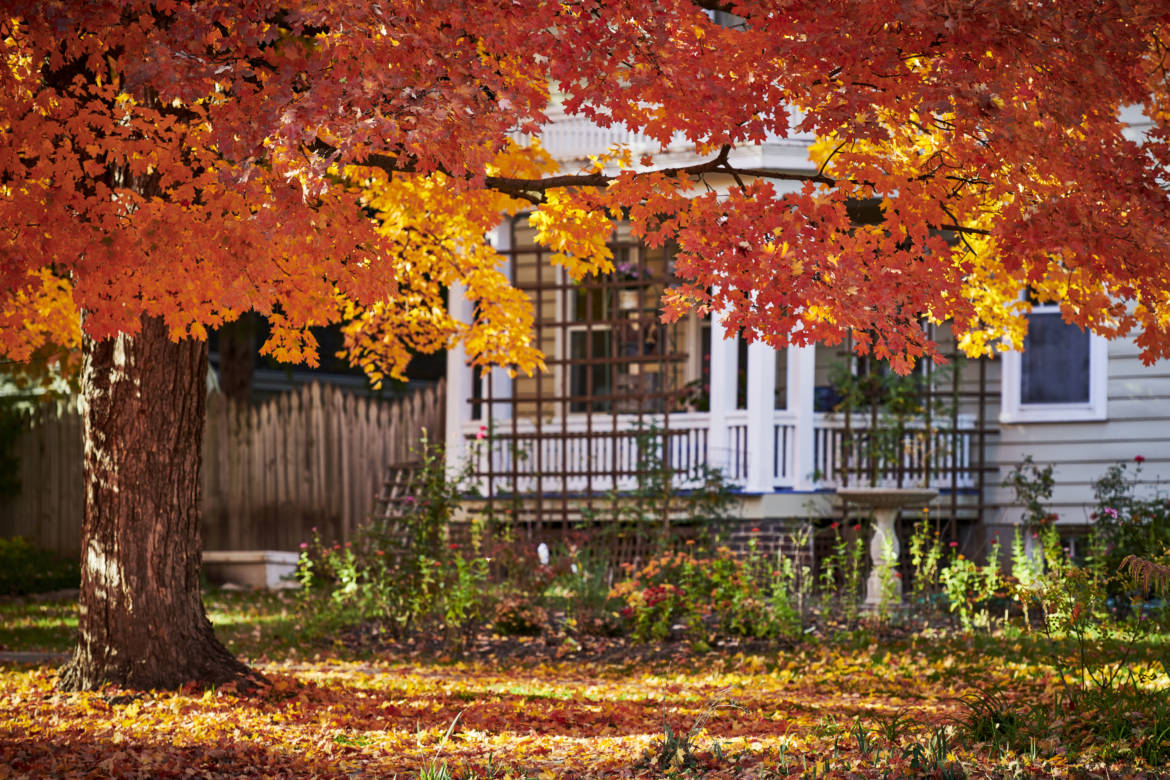Fall Home Maintenance Guide

Fall is finally here, which means winter is right around the corner. In the colder parts of the country, those winter months can reap costly damage if homeowners aren’t prepared. Below are some tips on fall home maintenance you should focus on this season.
1. Trees, Shrubs, & Garden
Falling tree limbs could be a major hazard in the winter, and fall is the perfect time to address them. A professional tree service will be able to examine the trees on your property for signs of failing health to help prevent tree loss, and prune correctly to avoid any branches falling off. Take extra care with any limbs that are growing close to the roof or power lines.
In the northern regions, fall is actually a great time to fertilize and reseed the lawn. Although the grass may appear to stop growing this time of year, its roots are actually growing deeper into the ground to prepare for the snowy months. Now is also a good time to prune any shrubs; after the leaves turn, a careful pruning will encourage healthy growth. When you’re finished, make sure to clean off your gardening tools before putting them in storage for winter.
2. Leaves
The changing leaves are synonymous with autumn, and can look beautiful covering the lawn. However, if not taken care of before the snow, those leaves can prevent growth in the spring. When large layers of leave get wet, then can become compact and suffocate the lawn beneath. This also facilitates an environment ripe for infestation and germs. By making sure to regularly rake the lawn, particularly before any snowfalls, you can help keep your lawn healthy for spring.
To make the job as easy as possible, put on some gardening gloves to protect your hands, use a lightweight rake, and scoop the piles into bags. However, you could also consider putting those leaves to good use in your garden. Leaves are rich in nutrients, and can be used for composting, insulating your garden, and enriching your soil. Just make sure to shred the leaves first. A leaf shredder will be most efficient, but a lawn mower will achieve the same results.
3. Gutters
All those leaves coming down can also clog your gutters and downspouts if left unchecked. When it rains, or the snow melts, clogged gutters will cause the water to pool which can cause damage to your siding or roof. It can also create ice dams To prevent this, make sure to regularly clean them out during the fall months. The drainage areas should be completely unblocked by leaves, twigs, or other debris.
For the roof, you’ll probably need to break out a ladder. Use extreme caution when doing this, or hire a professional if you’re unsure. And to save yourself headaches in the future, consider installing some gutter guards to prevent clogging.
4. Safety
Those of you that live in seasonally cold regions know how dangerous it can be just to walk to your front door when it’s icy out. To prepare, make a point in the fall to look for wobbly railings or loose stairs, and refasten or replace anything that doesn’t feel sturdy. Also take a look at your driveway and walkways- smooth surfaces make for much easier shoveling, so repair any cracks or consider repaving if needed.
If you’ve never checked for radon, fall is a good time to do so. As the weather gets colder, you’re more likely to keep the windows and doors shut more often- and trap radon in, which is very harmful at high levels. While you’re at it, test your smoke and carbon monoxide detectors and replace any batteries as needed. Finally, if you own a wood-burning fireplace, be sure to inspect and clean it before the cold weather sets in to prevent carbon monoxide poisoning and chimney fires.
5. Plumbing
An commonly known but easily forgotten rule is to shut off the water to your exterior faucets before temperatures drop below freezing and the pipes freeze and burst. In case the pipes do freeze, make sure you know where your shut-off valve is located. Any hoses should not only be drained, but also stored indoors before the winter- leaving them attached could cause water to back up in the pipes and freeze.
If you have an irrigation system, this will also need to be drained. Irrigation lines, even if buried, can freeze in the winter and leave you with busted pipes and sprinklers. The process to drain the system will differ depending on whether it is a manual or automatic valve, so research carefully.
6. Insulate
According to Energy.Gov, between 25% to 30% of residential heating use is due to heat loss through windows. To save on energy this winter, weatherstripping is an easy, low-cost solution. Apply the stripping around windows and doorframes to seal the heat inside. Door sweeps can also help along the bottoms of drafty doors. For additional energy saving, grab some exterior caulk and take a trip around the exterior of the home to seal any cracks between the trim and siding.
Next, journey up to the attic to make sure the insulation is still in order. If installed correctly, the vapor barrier should be facing down; if it’s facing up, it will trap moisture and cause water damage. Also, make sure the insulation isn’t covering any vents, which could cause ice dams on the roof.
7. HVAC
If you have window air conditioning units, fall is the time to take those down. If that’s not possible, use an insulating wrap to cover the exterior of the unit to prevent drafts. For central units, it’s not necessary to wrap the entire unit for the winter- doing so can actually cause condensation, which could corrode the unit. However, it is smart to place a piece of plywood on top of the unit for protection from falling icicles in the winter.
Now for your furnace or heating system. Make sure to replace the filters before you start using it regularly. This is something homeowners should do every 2-3 months regardless, but if you’re behind on the maintenance, now is the time. The system should also be inspected and cleaned by a licensed HVAC technician- this is important to avoid carbon monoxide poisoning, and ensure peak performance through the winter.




